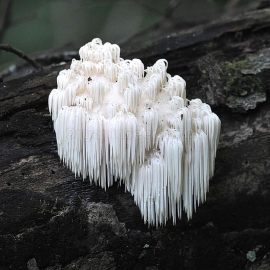 EXCLUSIVE
EXCLUSIVE






Lion’s Mane / Hericium erinaceus - Organic Mushroom Spawn
6.10 €
Lion’s Mane is a beautiful and unusual ‘teethed’ mushroom comprised of layers of soft cascading spines. It gets its name from the Lion’s Mane Jellyfish not from the big cat! Lion’s Mane is now a rare find in the wild.
-
Lion’s Mane Organic Mushroom Plug Spawn
Lion’s Mane is a beautiful and unusual ‘teethed’ mushroom comprised of layers of soft cascading spines. It gets its name from the Lion’s Mane Jellyfish not from the big cat! Lion’s Mane is now a rare find in the wild, and is classed as an endangered mushroom species in Europe. Also called ‘Monkey Head’, ‘Bearded Tooth’ and ‘Pom-Pom Blanc’.
Lion’s Mane is a slower colonising mushroom, so wide logs and larger tree stumps are not recommended for this species. However, a little patience is rewarded with a superb seafood-like taste, and a melt-in-the-mouth texture that has been compared to lobster or tender veal. Excellent stir-fried in butter or olive oil, complimenting many different dishes.
Season
Produces annually in late summer from August to early October, in response to heavy and prolonged rainfall.
Tree Species
All hardwoods are suitable, and also fruit and nut trees, but the results can be unpredictable using the latter two. Preferred species: Alder, Beech, Birch, Chestnut, Cherry, Oak, Walnut.
Timber Selection
When compared to other mushroom species, Lion’s Mane is considered a ‘slower coloniser’, so thinner boughs and limbs are recommended (with a diameter of no more than 15 cm) to achieve colonisation in 12 to 18 months. Wider logs can be used, but it may take 3-5 years before colonisation is complete. To help Lion’s Mane establish quickly on wide logs, we recommend a minimum purchase of 60 plugs.
